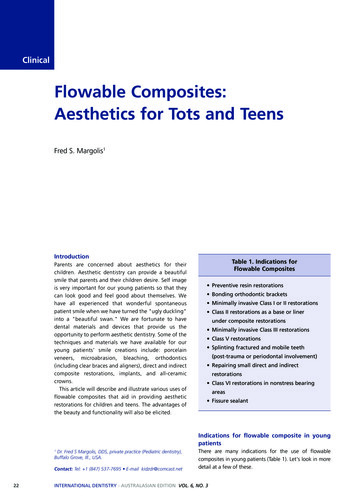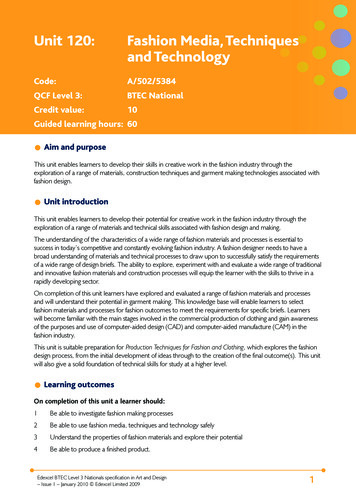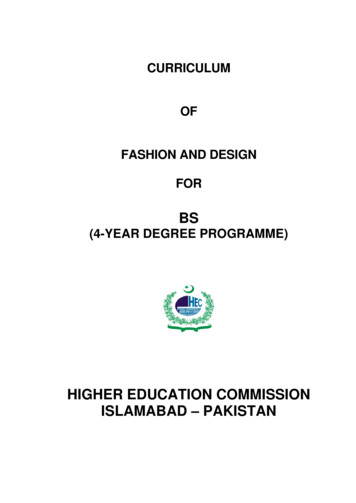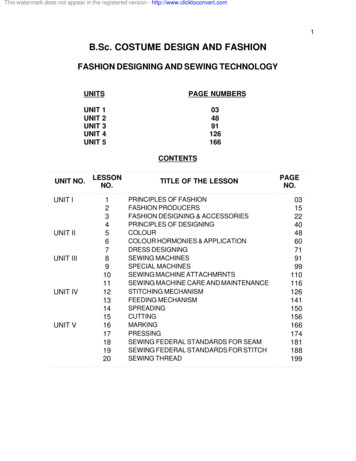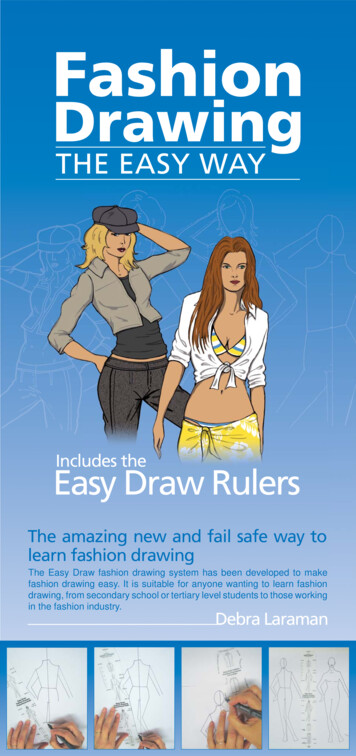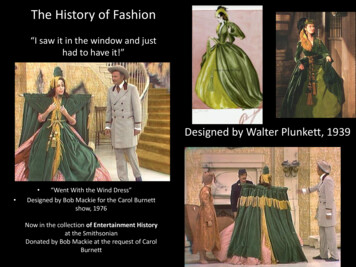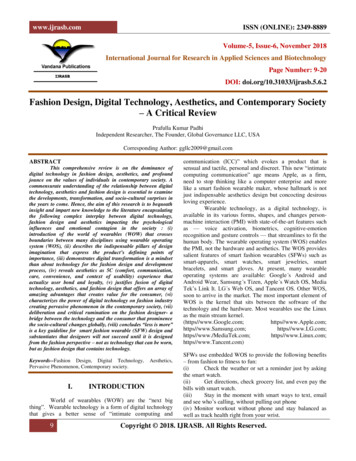
Transcription
www.ijrasb.comISSN (ONLINE): 2349-8889Volume-5, Issue-6, November 2018International Journal for Research in Applied Sciences and BiotechnologyPage Number: 9-20DOI: doi.org/10.31033/ijrasb.5.6.2Fashion Design, Digital Technology, Aesthetics, and Contemporary Society– A Critical ReviewPrafulla Kumar PadhiIndependent Researcher, The Founder, Global Governance LLC, USACorresponding Author: ggllc2009@gmail.comABSTRACTThis comprehensive review is on the dominance ofdigital technology in fashion design, aesthetics, and profoundjounce on the values of individuals in contemporary society. Acommensurate understanding of the relationship between digitaltechnology, aesthetics and fashion design is essential to examinethe developments, transformation, and socio-cultural surprises inthe years to come. Hence, the aim of this research is to bequeathinsight and impart new knowledge to the literature encapsulatingthe following complex interplay between digital technology,fashion design and aesthetics impacting the psychologicalinfluences and emotional contagion in the society : (i)introduction of the world of wearables (WOW) that crossesboundaries between many disciplines using wearable operatingsystem (WOS), (ii) describes the indispensable pillars of designimagination that express the product’s defining points ofimportance, (iii) demonstrates digital transformation is a mindsetthan about technology for the fashion design and developmentprocess, (iv) reveals aesthetics as 5C (comfort, communication,care, convenience, and context of usability) experience thatactualize user bond and loyalty, (v) justifies fusion of digitaltechnology, aesthetics, and fashion design that offers an array ofamazing advantages that creates value for the consumer, (vi)characterizes the power of digital technology on fashion industrycreating pervasive phenomenon in the contemporary society, (vii)deliberation and critical rumination on the fashion designer- abridge between the technology and the consumer that prominencethe socio-cultural changes globally, (viii) concludes “less is more”is a key guideline for smart fashion wearable (SFW) design andsubstantiates that designers will not succeed until it is designedfrom the fashion perspective – not as technology that can be worn,but as fashion design that contains technology.Keywords--Fashion Design, Digital Technology,Pervasive Phenomenon, Contemporary society.I.Aesthetics,INTRODUCTIONWorld of wearables (WOW) are the ―next bigthing‖. Wearable technology is a form of digital technologythat gives a better sense of ―intimate computing and9communication (ICC)‖ which evokes a product that issensual and tactile, personal and discreet. This new ―intimatecomputing communication‖ age means Apple, as a firm,need to stop thinking like a computer enterprise and morelike a smart fashion wearable maker, whose hallmark is notjust indispensable aesthetics design but concocting desirousloving experience.Wearable technology, as a digital technology, isavailable in its various forms, shapes, and changes personmachine interaction (PMI) with state-of-the-art features suchas — voice activation, biometrics, cognitive-emotionrecognition and gesture controls — that streamlines to fit thehuman body. The wearable operating system (WOS) enablesthe PMI, not the hardware and aesthetics. The WOS providessalient features of smart fashion wearables (SFWs) such assmart-apparels, smart watches, smart jewelries, smartbracelets, and smart gloves. At present, many wearableoperating systems are available: Google s Android andAndroid Wear, Samsung s Tizen, Apple s Watch OS, MediaTek‘s Link It. LG s Web OS, and Tancent OS. Other WOS,soon to arrive in the market. The most important element ofWOS is the kernel that sits between the software of thetechnology and the hardware. Most wearables use the Linuxas the main stream ancent.com)SFWs use embedded WOS to provide the following benefits– from fashion to fitness to fun:(i)Check the weather or set a reminder just by askingthe smart watch.(ii)Get directions, check grocery list, and even pay thebills with smart watch.(iii)Stay in the moment with smart ways to text, emailand see who‘s calling, without pulling out phone(iv) Monitor workout without phone and stay balanced aswell as track health right from your wrist.Copyright 2018. IJRASB. All Rights Reserved.
www.ijrasb.comISSN (ONLINE): 2349-8889Technological amelioration in the last five decadesinvolves enrichment of wearable technology and wearabledesign techniques. The future of wearable technology is notjust on your wrist or body but to expect to be invisible. Theyare reality into everyday lives and can change the evolutiontrends disrupting the fashion business globally. Cutting-edgedigital technological enrichment in the digital agerevolutionize industries like fashion shaping the tomorrow tore-imagine the future by transforming the realities of todayThe potential convenience, greater range of features and newtechnological innovations like artificial intelligence, blockchain, cloud computing, 4D printing, smart dust, stretchablebatteries, Pico technology, augmented reality, virtual reality,Internet of soft things, synthetic biology, and sartorialrobotics seem to hint at a brighter future for smart fashionwearables. One should have a design philosophy not to leaveany detail unnoticed because one never knows what casualday-to-day thing might become the next influential aspect ofa new, groundbreaking design.This study refers to smart fashion wearable (SFW) as smarttextiles, e-textiles, smart watches, smart bracelets, smartpendants, jewelry, accessories for various applications in thefashion industry. In this era of leap change, one tends toeasily adapt to the smart fashion wearables and the growth ofSFW promises far more powerful and cost-effective in thedays to come. Smart fashion wearables (SFWs) are thebiggest innovation in digital technology that crossesboundaries between many disciplines and will not succeed asa market until it is designed from the fashion position – notas technology that can be worn, but as- ―fashion logy‖ [1]fashion design that contains technology.In this comprehensive review the terminology usedsurrounding the fashion design, the author has coined―Couture logy‖ [2] and the different terms related to couture,haute couture, fashion, fast fashion, ethical fashion, ethicalcognitive couture etc. refers to the SFW phenomenon usedinterchangeably in this study.II.DESIGN IMAGINATION DEFINEPOINT OF SIGNIFICANCEEvery design imagination is a process for theformulation of ideas and fulfilling the needs of a market. Thedesign solutions must meet and solve customer problemsthrough the lens of the firm's vision and mission. Designthinking should be guided by the following key elements asthe foundation to create a solution to solve users‘ problems:Strategy - Identifies the opportunity space (who, why,where) and must have calibration criteria.Principles - Guiding values that outlines the attributes of aspecific solution.Pillars - The user experience structure that defines thesolution‘s salient points of relevance. A good design isdriven by human connection. Based on author‘s extensiveexperience as a product marketing practitioner, a good design10depends on the execution of the following six pillars, asshown in figure 1, to attain the best solution prior to designthinking process:(i)Empathy is the intimate connection with theconsumer feeling to meet the need of the consumercompassion.(ii) Simplicity is ease of use to make things intuitivelyobvious.(iii) Craft is the aesthetics and quality to be carried fromconcept to consumer experience.(iv) Impute presents the fashion designers cohesivenessin a creative manner.(v)Friendliness is the biggest leap comes from userexperience through intuitive plug and play.(vi) Focus is to eliminate all inconsequentialopportunities.Figure1. Pillars of DesignIII.DIGITAL TRANSFORMATION – AMINDSET THAN ABOUT TECHNOLOGYNo amount of digital technology can successfullychange a firm; but with the right mindset, company‘scustomer value creation, and sustainable competitiveadvantage is possible. Mindset is at the core of culturecreation, strategy formation and management. Theramifications of the digital mindset enable fashion designersto lead and create cultures where empowerment, speed ofexecution, and learning are hallmarks of an organizationincluding change in management for digital transformation.In the digital age, a fashion firm must begin with anappropriate mindset prior to deploying digital technologies.Big data is the new currency of digital technology era.Fashion design team must alter their mindset from atraditional view of data being expensive to manage. Legacyview of innovation is where testing new ideas was expensive,slow, daunting, and failure was to be avoided at all costs.This traditional mindset must change to view innovation in aCopyright 2018. IJRASB. All Rights Reserved.
www.ijrasb.comISSN (ONLINE): 2349-8889way to embark on testing ideas in the digital world is quick,inexpensive, easy, and where mistakes are learned early. Inthe legacy world, value was often defined and judged by theimpact on business. In the digital world value is viewedwithin the context of customer needs and to uncover thefuture opportunity to create customer value. Thus, digitaltransformation of a fashion brand is more about mindset thanabout technology.Digital technology and the fashion design processchallenges the potential of digital interventions for fashiondesigners. The digital domain design requires access topractical tools, workspaces and digital skills development fordesigners to take advantage of underpinning the rise of thedigital economy.One needs to know the vision, mission, objective ofthe design and development process. Prior to incorporationof digital technology in fashion design, it is essential tounderstand the impact of technology on the design anddevelopment process. The intangible ideas must be convertedto a product through technology, and manufacturingprocessesThe development of smart fashion wearablesdemands the merging of embedded wearable technology,aesthetics and fashion design. A wide gap still exists in theprovision of designers with a common language to appreciatethe disparate mix of aesthetic, beauty, style, taste, technicaland cultural needs of the potential market for smartwearables. The design and development of smart fashionwearables crosses the boundaries between disciplines suchas fashion design, digital technology, human biology,electronics, multimedia, interaction design and marketing.The new smart wearable design discipline embracescreativity and aesthetic, style, beauty, taste awarenesscombined with a sound requirement for technicalunderstanding and innovation. The most addressed needs andrequirements of SFW design are: (i) customer parameterneeds, (ii) materials requirements, (iii) technologyparameters requisite, (iv) functional essentials, (v)performance & quality committal, (vi) design and anesthetics exigency, (vii) economical longing, (viii) standardsand regulation compliance, (ix) sustainability.Design and development process using specificstrategy is to shape that intangible idea into a commercialproduct as shown in the following steps and figure 2:11Figure 2. Design & Development Process for Value Creation(i)Brainstorming of possible ideas to meet the marketneed in an entrepreneurial spirit to come up with a newidea begins by defining the objective. Refining the ideatakes time to develop, plan and test to make sure to reachoptimal success. One can use various techniques tobrainstorm a new idea or combine various techniques toattain the idea.(ii)Creating prototype is an early sample of a productready for performing analpha test of a concept to learnedfrom and make sure the features, functions andperformance meets the market need.(iii)Alphatesting is used for the first sample prototypetest of apotential product. At the alpha testing phase, theprototype may have flaws with unfinished documentationand goes through iterations. The prototype variants maychange certain features, functions and performance. Theprototyping engineers fix the flaws and make necessarychanges based on the test feedbacks. Once the alphatesting phase of the prototype meets the pre-determinedspecification and closely matches with the envisionedproduct, it goes to the beta testing phase after the qualityassurance is attained.(iv)Qualityassurance is a way of avoiding flaws anddefects in manufactured products and systematically takingactions to enhance development cycles.(v)Betatesting is to evaluate customer satisfaction toensure release readiness.(vi)Generating a product and get ready for field testing.(vii)Field testing at prospective customers locations toevaluate the adoption of the product.(viii)Commercial product - at this juncture, designersneed to launch a commercial product to enhance thecustomer value,(ix) Customer Value Proposition/Effective ValueProposition/ Value Creation - The following steps areessential to improve the customer value: Focus on most valuable customers. Understanding what is important to customers. Meaning what drives value for customers. Discerning Customer Value Proposition. Creating more value relative to competitors.Copyright 2018. IJRASB. All Rights Reserved.
www.ijrasb.comISSN (ONLINE): 2349-8889The customer parameter needs are the CustomerValue Proposition (CVP) that solves customer problem andsatisfies customer need. In this sense, the CVPtest-drivingoffers a fruitful context for managers to involve frontlineemployees and use their creativity and expertise and is anaggregation of benefits that a fashion company offers to itscustomers. Hence, to devise an effective value proposition(EVP), one must understand the market from a c
technology, aesthetics and fashion design is essential to examine the developments, transformation, and socio-cultural surprises in the years to come. Hence, the aim of this research is to bequeath insight and impart new knowledge to the literature encapsulating the following complex interplay between digital technology, fashion design and aesthetics impacting the psychological




